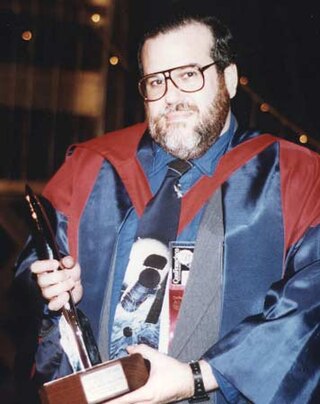
A fanzine is a non-professional and non-official publication produced by enthusiasts of a particular cultural phenomenon for the pleasure of others who share their interest. The term was coined in an October 1940 science fiction fanzine by Russ Chauvenet and first popularized within science fiction fandom, and from there the term was adopted by other communities.

A fandom is a subculture composed of fans characterized by a feeling of camaraderie with others who share a common interest. Fans typically are interested in even minor details of the objects of their fandom and spend a significant portion of their time and energy involved with their interest, often as a part of a social network with particular practices, differentiating fandom-affiliated people from those with only a casual interest.

Science fiction first appeared in television programming in the late 1930s, during what is called the Golden Age of Science Fiction. Special effects and other production techniques allow creators to present a living visual image of an imaginary world not limited by the constraints of reality.

Science fiction fandom or SF fandom is a community or fandom of people interested in science fiction in contact with one another based upon that interest. SF fandom has a life of its own, but not much in the way of formal organization.

A zine is a small-circulation self-published work of original or appropriated texts and images, usually reproduced via a copy machine. Zines are the product of either a single person or of a very small group, and are popularly photocopied into physical prints for circulation. A fanzine is a non-professional and non-official publication produced by enthusiasts of a particular cultural phenomenon for the pleasure of others who share their interest. The term was coined in an October 1940 science fiction fanzine by Russ Chauvenet and popularized within science fiction fandom, entering the Oxford English Dictionary in 1949.

A science-fiction fanzine is an amateur or semi-professional magazine published by members of science-fiction fandom, from the 1930s to the present day. They were one of the earliest forms of fanzine, within one of which the term "fanzine" was coined, and at one time constituted the primary type of science-fictional fannish activity ("fanac").
Slash fiction is a genre of fan fiction that focuses on romantic or sexual relationships between fictional characters of the same sex. While the term "slash" originally referred only to stories in which male characters are involved in an explicit sexual relationship as a primary plot element, it is now also used to refer to any fan story containing a romantic pairing between same-sex characters. Many fans distinguish slash with female characters as a separate genre, commonly referred to as femslash.

Science fiction conventions are gatherings of fans of the speculative fiction subgenre, science fiction. Historically, science fiction conventions had focused primarily on literature, but the purview of many extends to such other avenues of expression as films, television, comics, animation, and games. The format can vary but will tend to have a few similar features such as a guest of honour, discussion panels, readings and large special events such as opening/closing ceremonies and some form of party or entertainment. Science fiction conventions started off primarily in the United Kingdom and the United States but have now spread further. Several countries have their own individual conventions, as well as playing host to rotating international conventions.
Mike Glyer is both the editor and publisher of the long-running science fiction fan newszine File 770. He has won the Hugo Award 12 times in two categories: File 770 won the Best Fanzine Hugo in 1984, 1985, 1989, 2000, 2001, 2008, 2016 and 2018. Glyer won the Best Fan Writer Hugo in 1984, 1986, 1988, and 2016. The 1982 World Science Fiction Convention (Worldcon) committee presented Glyer a special award in 1982 for "Keeping the Fan in Fanzine Publishing."
Betty JoAnne Trimble, known as Bjo, is an American science fiction fan and writer, initially entering fandom in the early 1950s.

Kirk/Spock, commonly abbreviated as K/S or Spirk and referring to James T. Kirk and Spock from Star Trek, is a popular pair in slash fiction, possibly the first slash pairing, according to Henry Jenkins, an early slash fiction scholar. Early in the history of Star Trek fan fiction, a few fan writers started writing about a romantic and sexual relationship between Kirk and Spock, highlighting a romantic or sexual element to the friendship between the men. As of 1998, most academic studies on slash fiction focused on Kirk/Spock, as Star Trek was by that point one of the longest-lived and most prosperous subjects of slash fiction, while its mainstream popularity made it one of the most accessible titles for academics and their audience. As the first slash pairing, K/S was created and developed largely independently from the influence of other slash fiction, with most of the conventions of the slash genre seeing their debut first in K/S slash.

Fans of the long-running British science fiction television series Doctor Who are referred to as Whovians, or collectively as the Doctor Who fandom.

Andrew Ian Porter is an American editor, publisher and active science fiction fan.

Janus was a feminist science fiction fanzine edited by Janice Bogstad and Jeanne Gomoll in Madison, Wisconsin, and closely associated with that city's science fiction convention, WisCon. It was repeatedly nominated for the Hugo Award for Best Fanzine ; this led to accusations that if Janus had not been feminist, it wouldn't have been nominated. Eighteen issues were published under this name from 1975 to 1980; it was succeeded by Aurora SF.
A Mary Sue is a type of fictional character, usually a young woman, who is portrayed as unrealistically free of weaknesses or character flaws. The term "Mary Sue" is often applied pejoratively to strong female heroines considered to be unrealistically capable, both in fan fiction and in commercially published fiction.

A Trekkie or Trekker is a fan of the Star Trek franchise, or of specific television series or films within that franchise. The show developed a dedicated and enthusiastic following shortly after it premiered, with the first fanzine premiering in 1967. The first fan convention took place the year the original series ended.
Jeanne Gomoll is an American artist, writer, editor, and science fiction fan, who was recognized as one of the guests of honor at the 72nd World Science Fiction Convention, having been a guest of honor at numerous previous science fiction conventions. She has been nominated multiple times for awards in artist and fanzine categories, and for service to the genre of science fiction, particularly feminist science fiction.
Sondra Marshak is an American science-fiction writer. She is most well known for her work co-written with Myrna Culbreath. She was a co-writer of Star Trek Lives! (1975), with Jacqueline Lichtenberg, and television producer Joan Winston. She was an early promoter of Star Trek fan culture, and a publisher of fan fiction.

Star Trek Lives! is a 1975 book, co-written by Jacqueline Lichtenberg, Sondra Marshak, and Joan Winston, which explored the relationship between the Star Trek television series and the fandom that emerged following the series' cancellation. It was published by Bantam Books.
Fan studies is an academic discipline that analyses fans, fandoms, fan cultures and fan activities, including fanworks. It is an interdisciplinary field located at the intersection of the humanities and social sciences, which emerged in the early 1990s as a separate discipline, and draws particularly on audience studies and cultural studies.











